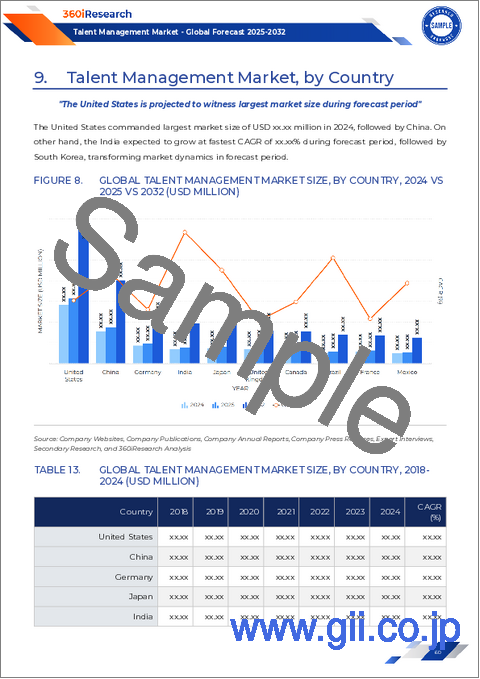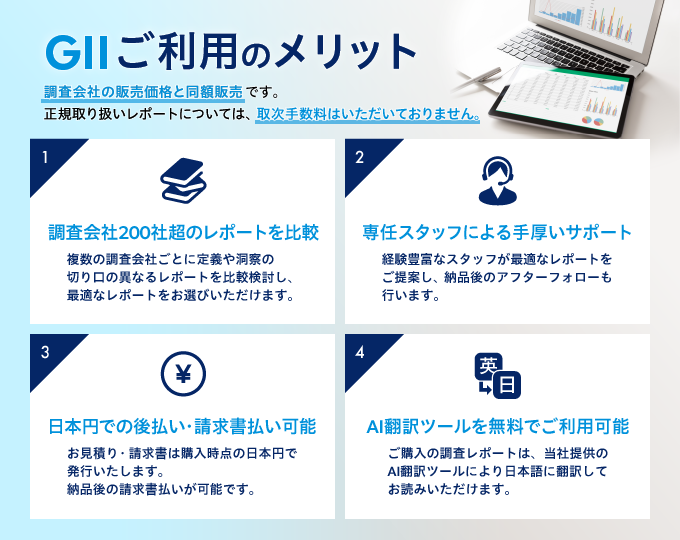|
|
市場調査レポート
商品コード
1830087
タレントマネジメント市場:提供サービス、展開モデル、組織規模、エンドユーザー産業別-2025-2032年の世界予測Talent Management Market by Offering, Deployment Model, Organization Size, End-User Industry - Global Forecast 2025-2032 |
||||||
カスタマイズ可能
適宜更新あり
|
|||||||
| タレントマネジメント市場:提供サービス、展開モデル、組織規模、エンドユーザー産業別-2025-2032年の世界予測 |
|
出版日: 2025年09月30日
発行: 360iResearch
ページ情報: 英文 189 Pages
納期: 即日から翌営業日
|
概要
タレントマネジメント市場は、2032年までにCAGR 10.85%で323億5,000万米ドルの成長が予測されています。
| 主な市場の統計 | |
|---|---|
| 基準年2024 | 141億8,000万米ドル |
| 推定年2025 | 156億5,000万米ドル |
| 予測年2032 | 323億5,000万米ドル |
| CAGR(%) | 10.85% |
タレントマネジメントダイナミクスと戦略的必須事項の簡潔な統合は、影響力の大きい労働力の決定に向けてシニアリーダーを導くために設計されています
このエグゼクティブサマリーは、今日のタレントマネジメントと人的資本テクノロジーを形成する重要なダイナミクスを統合し、意思決定に必要な簡潔でエビデンスに基づく洞察を必要とするシニアリーダー、人事担当役員、戦略的投資家を導くことを意図しています。労働力構成、テクノロジー導入、規制の変化、購買者の行動などの動向を、戦略立案、ベンダー選定、能力構築を支援する明確なストーリーに集約しています。分析では、抽象的な理論化よりも、現実的な意味合いと行動への道筋を強調し、リーダーが状況認識と実行可能な選択肢の両方を必要としていることを認識しています。
この文書では、魅力、定着率、生産性、コンプライアンスの測定可能な改善を促進する、プロセスの再設計、テクノロジーの有効化、能力開発といった業務上のテコに焦点を当てることで、ビジネス戦略とワークフォース変革の接点を組み立てています。また、デジタルHRプラットフォーム、アナリティクス、スキルフレームワークがどのようにリスクを軽減し、パフォーマンスを加速させるために適用されているかを紹介し、ガバナンス、データハイジーン、部門横断的なスポンサーシップなど、採用のための組織の前提条件について概説しています。また、ガバナンス、データハイジーン、部門横断的なスポンサーシップなど、組織における採用の前提条件を概説しています。全体を通して、グローバルな文脈を前提としながらも、カスタマイズされた対応が必要となる地域特有の変曲点を特定しています。読者は、行動可能で、最新のエビデンスに基づき、今後12~36カ月の優先順位設定をサポートするように構成された、統合された発見を見つけることができます。
ハイブリッドワーク、AI統合、スキルベース採用、臨時雇用、DEIの進化、規制の複雑性が、タレントマネジメントモデルをどのように再構築しているか
タレントマネジメントを取り巻く環境は、組織が能力を惹きつけ、開発し、維持する方法を再構築する、一連の変革的シフトを経ています。ハイブリッド・ワークやリモート・ワークのモデルは、従来の地域を超えて人材プールを拡大し、企業は人材調達、報酬、業績測定の見直しを迫られています。同時に、人工知能と機械学習は、実験的なパイロットから、採用、学習、人材分析全体に組み込まれた機能へと成熟し、候補者のスクリーニングの迅速化、パーソナライズされた学習経路、離職予測モデルを可能にしました。このような技術の進歩は、新たな可能性を生み出すと同時に、組織が積極的に対処しなければならないガバナンスや倫理上の問題を提起しています。
同時に、スキルベースの雇用が勢いを増しており、雇用主は正式な資格よりも実証可能な能力を優先するため、アセスメントツールやキャリアマッピングシステムへの投資が必要となります。臨時労働者やプロジェクトベースの人材派遣の台頭は、労働力計画に複雑さをもたらし、人事チームはギグワーカーを労働力データとコンプライアンス・プロセスに統合する必要に迫られています。ダイバーシティ、エクイティ、インクルージョンの取り組みは、報告指標から、偏見の緩和と公平なキャリアパスに焦点を当てた体系的な介入へと進化しています。最後に、特に給与計算、福利厚生、データプライバシーが交差する領域で、規制当局の監視と国境を越えたコンプライアンスの課題が激化しており、複数の管轄地域の要件を管理できる統合プラットフォームへの需要が高まっています。これらのシフトが相まって、よりモジュール化された、データ主導の、倫理的配慮のあるタレントマネジメントへのアプローチが生まれつつあります。
関税主導の経済シフトが、ワークフォースフットプリントの決定、ベンダー選定、自動化導入、社内モビリティ戦略にどのような影響を与えるかを評価します
関税や貿易措置の発動は、サプライチェーンを超えて、労働市場、人材調達戦略、人材管理の経済性にまで波及する可能性があります。関税に起因するコスト圧力は、しばしば企業にグローバルフットプリントの見直しを促し、リショアリングやニアショアリングの決定を加速させ、ひいては地域の人材プールに対する需要を変化させる可能性があります。企業は、関税の影響を軽減するために事業を移転または統合する際、人材配置、再教育、現地コンプライアンスに関する新たな要件に直面します。
関税は、人事テクノロジーのベンダー選定や総所有コスト評価にも影響します。ハードウェアや特定のサービスに対する関税が上昇すると、企業は資本支出を削減し、より予測可能な業務支出を可能にするクラウドベースのソリューションを選好するようになります。さらに、利益率の圧縮に直面している組織は、人事業務の自動化と効率化を優先し、ロボットによるプロセス自動化、AIを活用した採用活動、合理化されたサポートサービスを採用し、スリムなチームでサービスレベルを維持する可能性があります。人材面では、関税による変動が、組織的な知識を維持し、外部雇用への依存を制限する機能横断的スキルと内部流動性プログラムの重要性を強調しています。これらのダイナミクスを総合すると、人材リーダーはマクロ経済シナリオを人材戦略に統合し、報酬フレームワーク、福利厚生設計、人材計画ツールが貿易関連のショックに直面しても柔軟性と回復力を維持できるようにする必要があります。
多角的なセグメンテーションの洞察により、製品、展開の選択肢、企業規模、業界の要請が、どのようにバイヤーの優先順位とソリューション設計を形成するかを明らかにします
市場をきめ細かく見るには、提供製品、展開の選択肢、組織規模、エンドユーザー業界が、どのように購買者の要件と採用パターンを形成しているかに注目する必要があります。サービスには、プロフェッショナルサービス、サポート、メンテナンス、トレーニング、教育などのアドバイザリーや導入の流れが含まれ、ソリューションには、報酬管理、従業員ライフサイクル管理、学習・トレーニング、学習管理システム、パフォーマンス管理、採用・人材獲得管理などのソフトウェアカテゴリーが含まれます。バイヤーは、円滑な導入と継続的な採用を確実にするために、継続的なサービスとプラットフォーム購入を組み合わせることが多く、そのバランスはバイヤーの洗練度と社内能力によって異なるため、この二分化は調達行動に影響を与えます。
クラウドベースのソリューションは、迅速なスケーラビリティと初期投資の削減を求める企業を惹きつけることが多いが、オンプレミス型の導入は、データの保存やカスタマイズの要件が厳しい企業にとって依然として適切です。大企業は通常、複雑な統合、グローバルコンプライアンスのサポート、高度な分析を要求するのに対し、中小企業は費用対効果、使いやすさ、迅速なTime-to-Valueを優先します。航空宇宙・防衛、銀行・金融サービス、ヘルスケア・ライフサイエンス、政府・公共部門などの分野では、高度なセキュリティ、厳格なコンプライアンス、専門的なトレーニングが求められる一方、消費財、小売・eコマース、メディア・エンターテイメント、ホスピタリティなどの分野では、季節ごとの人員計画や顧客対応スキル開発における俊敏性が重視されます。これらのセグメンテーションを総合すると、ベンダーとバイヤーが、ソリューション設計、サービス提供、市場投入アプローチを特定のバイヤーのニーズに合致させるために利用できる、多次元的なマップとなります。
南北アメリカ、欧州、中東・アフリカ、アジア太平洋市場におけるタレントマネジメントの優先事項における地域力学と差別化
地域ダイナミックスは、タレントマネジメントの優先順位、テクノロジー導入率、規制上の制約に強い影響を及ぼし、主要地域間で明確なビジネスチャンスの場を生み出しています。南北アメリカでは、企業は引き続きワークフォース・アナリティクス、ダイバーシティ・イニシアチブ、ハイブリッド・モデルをサポートするクラウドネイティブ・プラットフォームを優先しており、成熟した労働市場と競争力のある人材プールが、従業員体験と業績連動型報酬への投資を促進しています。欧州、中東・アフリカでは、データ保護と雇用法をめぐる規制の複雑さが中心的な関心事となり、企業はコンプライアンス機能、多言語サポート、地域ごとのパートナーエコシステムを重視し、法域を超えた合法的で一貫性のある業務を確保するよう求められています。
アジア太平洋地域では、急速な経済開拓、多様な労働市場、デジタルトランスフォーメーションへの高い意欲が、スケーラブルなクラウドソリューション、モバイルファーストの学習プラットフォーム、ローカライズされた人材獲得戦略を好む市場を形成しています。アメリカ大陸では人材確保と再教育にイノベーションが求められ、欧州、中東・アフリカでは高度なガバナンスと地域ごとのカスタマイズが求められ、アジア太平洋ではスピード、ローカライゼーション、より広範な企業のデジタル化プログラムとの統合が優先されるなど、地域ごとに異なる課題があります。ベンダーにとってもバイヤーにとっても、これらの地域的なニュアンスを認識することは、展開ロードマップを作成し、価格モデルを設計し、製品の機能を順序立てて関連性と採用率を最大化するために不可欠です。
ベンダーの戦略とバイヤーの選択を形成する、既存プラットフォーム、クラウドネイティブな課題、サービスプロバイダー間の競合とパートナーシップのダイナミクス
タレントマネジメントエコシステムにおける大手企業の競合行動から、競争とパートナーシップに影響を与える戦略パターンが明らかになりました。既存ベンダーは、プラットフォームの統合、アナリティクスの組み込み、グローバルコンプライアンス機能の拡充に投資を続け、企業アカウントを守り、従業員のライフサイクル全体の摩擦を減らす統合スイートを構築しています。同時に、クラウドネイティブの課題者と垂直専門家は、優れたユーザーエクスペリエンス、より迅速な実装、独自の規制要件や運用要件に対応する業界固有の機能を提供することで、支持を集めています。この2つの動きが並行することで、相互運用性とパートナーネットワークがますます成功を左右する、二元的な競合情勢が形成されています。
特に、変更管理、データ移行、プロセス再設計が不可欠な大規模な変革プログラムでは、サービスプロバイダーやコンサルタント会社が極めて重要な役割を果たします。テクノロジーベンダーとアドバイザリー会社の戦略的提携は、専門分野の知識と技術提供能力を組み合わせることで、導入を加速させる。さらに、プラットフォームの拡張性、マーケットプレースのエコシステム、サードパーティの統合に注目が集まっており、顧客はワークフォースの真実の情報源を一元管理しながら、最善のソリューションを組み立てることができます。バイヤーにとって、ベンダーの選択決定は、機能の同等性よりも、オープン性、ベンダーの対応力、類似業界における実証済みの成功事例などのロードマップにかかっています。ベンダーにとって、差別化には、開発者エコシステム、認定プログラム、顧客のKPIに結びついた測定可能な成果への投資がますます必要になっています。
モジュラープラットフォーム、スキルフレームワーク、AI導入、ガバナンス、シナリオプランニングを通じて人材戦略を近代化するための、リーダーへの実践的でインパクトの大きい提言
リーダーは、実行リスクを軽減しつつ、タレント戦略を組織目標に合致させる一連の現実的な行動を追求すべきです。第一に、迅速な統合を促進し、ベンダーのロックインを低減するモジュラー・プラットフォームとオープンAPIへの投資を優先します。第二に、スキル分類法とコンピテンシーフレームワークを採用、学習、パフォーマンスのプロセスに組み込むことで、社内の流動性を高め、外部採用への依存を減らします。第三に、AIと自動化の採用を選択的に加速させ、候補者のマッチング、学習のパーソナライゼーション、管理業務の自動化など、価値の高い使用事例に焦点を当て、戦略的業務に人事の能力を解放します。
同様に重要なのはガバナンスです。人事、IT、法務、事業部門間の整合性を確保するために部門横断的なスポンサーシップを割り当てると同時に、労働力データの明確なスチュワードシップとAI利用の倫理的ガイドラインを確立します。採用を維持するために、チェンジマネジメントと継続的学習に投資し、成功指標と柔軟な価格設定を含む契約を交渉することで、商業モデルと成果を一致させる。最後に、ビジネスリーダーが迅速にピボットできるように、マクロ経済の変動要因、貿易上の考慮事項、人材供給リスクを統合したシナリオベースの労働力計画を策定します。これらの対策を実施することで、組織は戦略的意図を業務能力と測定可能なビジネスインパクトに変換することができます。
実務家インタビュー、ベンダー評価、2次分析、三角測量、検証を組み合わせた透明性の高い多方式調査アプローチにより、実用的な発見を確実にします
この分析の基礎となる調査は、堅牢性、妥当性、実用性を確保するために、複数の補完的アプローチを組み合わせています。主なインプットとして、上級人事実務者、人材リーダー、テクノロジーバイヤーとの構造化インタビューがあり、採用の障壁、調達基準、導入の課題に関する定性的な背景を提供しています。これらの洞察は、ベンダーのブリーフィングや製品デモンストレーションと比較し、能力の主張を検証し、実際の統合パターンを観察します。2次調査には、業界レポート、規制ガイダンス、学術文献が含まれ、より広範な動向分析と地域規制の背景に情報を提供しています。
データの統合は、異なる視点を調整し、情報源間で一貫したテーマを浮き彫りにするために、厳密な三角測量に頼りました。セグメンテーション・マッピングは、製品、展開、組織規模、業界の次元が有意義に区別され、洞察が明確なバイヤー集団の特定のニーズに対応するように適用されました。検証ラウンドでは、経験豊富な実務家によるピアレビューや、さまざまな経済・規制条件下での推奨事項の回復力を確認するためのシナリオテストが行われました。調査手法は透明性と再現性を意図的に重視し、主要な前提条件、インタビュープロトコル、調査対象基準を文書化することで、利害関係者が調査結果をそれぞれの事業環境に適用できるかどうかを評価できるようにしました。
労働力の優位性を確保するためには、モジュール型プラットフォーム、スキルに基づくアプローチ、ガバナンス、地域情報に基づく戦略が不可欠であることを強調した結論の総括
サマリーをまとめると、タレントマネジメントは、技術的能力、労働力への期待、規制上の要求が収束し、戦略的意思決定がより緊急かつ重大なものとなる変曲点にあります。ガバナンスとチェンジマネジメントに投資しながら、モジュール化されたスキル中心のアプローチを採用する組織は、デジタルHR投資から価値を実現するのに有利な立場になると思われます。地域的なニュアンス、展開の好み、業界特有の要件が相互に影響し合うため、画一的なアプローチでは成功しにくいです。
貿易力学や関税によるコストシフトを含むマクロ経済的圧力の累積的影響は、適応力のある労働力計画と、内部流動性と効率性の再重視の必要性を強調しています。オープンであること、迅速な導入が可能であること、業界の専門知識が実証されていることを示すベンダーやサービス・プロバイダーは、調達決定において優先権を獲得すると思われます。最終的に、競争優位への道は、人材戦略、テクノロジー、ガバナンスの統合管理を通じて切り開かれます。
目次
第1章 序文
第2章 調査手法
第3章 エグゼクティブサマリー
第4章 市場の概要
第5章 市場洞察
- 従業員の能力開発パスをパーソナライズするためのAI駆動型スキルギャップ分析プラットフォームの実装
- 仮想現実ベースの没入型トレーニングモジュールを統合し、リモートワークフォースの熟練度を向上
- エンゲージメントを高めるために、年間レビューサイクルを通じて継続的なパフォーマンス向上システムを導入する
- 予測的な人材分析を活用し、積極的な後継者計画と人材維持リスクの軽減を図る
- ジャストインタイムの専門スキル構築をサポートするモバイルファーストのマイクロラーニングアプリケーションの導入
- 従業員の健康とメンタルヘルスの指標をタレントマネジメントと保持戦略に統合する
第6章 米国の関税の累積的な影響, 2025
第7章 AIの累積的影響, 2025
第8章 タレントマネジメント市場:提供別
- サービス
- プロフェッショナルサービス
- サポートとメンテナンス
- トレーニングと教育
- ソリューション
- 報酬管理
- 従業員ライフサイクル管理
- 学習とトレーニング/学習管理
- パフォーマンス管理
- 採用/人材獲得管理
第9章 タレントマネジメント市場展開モデル別
- クラウドベース
- オンプレミス
第10章 タレントマネジメント市場:組織規模別
- 大企業
- 中小企業
第11章 タレントマネジメント市場:エンドユーザー業界別
- 航空宇宙および防衛
- 銀行、金融サービス、保険
- 消費財・小売
- 教育
- エネルギー・公益事業
- 政府および公共部門
- ヘルスケアとライフサイエンス
- 情報技術と通信
- 製造業
- メディア&エンターテイメント
- 小売・Eコマース
- 運輸・物流
- 旅行とホスピタリティ
第12章 タレントマネジメント市場:地域別
- 南北アメリカ
- 北米
- ラテンアメリカ
- 欧州・中東・アフリカ
- 欧州
- 中東
- アフリカ
- アジア太平洋地域
第13章 タレントマネジメント市場:グループ別
- ASEAN
- GCC
- EU
- BRICS
- G7
- NATO
第14章 タレントマネジメント市場:国別
- 米国
- カナダ
- メキシコ
- ブラジル
- 英国
- ドイツ
- フランス
- ロシア
- イタリア
- スペイン
- 中国
- インド
- 日本
- オーストラリア
- 韓国
第15章 競合情勢
- 市場シェア分析, 2024
- FPNVポジショニングマトリックス, 2024
- 競合分析
- 15Five, Inc.
- ADP, Inc.
- Ascender HCM Pty Ltd
- Avature Limited
- Bamboo HR LLC
- Cornerstone OnDemand, Inc.
- Guidant Global Inc.
- Haufe Group SE
- International Business Machines Corporation
- Keka Inc.
- Kissflow Inc.
- Leapsome GmbH
- Learning Technologies Group PLC
- Motivosity Inc.
- Oracle Corporation
- Paylocity Holding Corporation
- Personio GmbH & Co. KG
- Randstad N.V.
- Rencai Group
- SAP SE
- SHL Global Management Limited
- Smartly.io Solutions Oy
- Wipro Limited
- Workday, Inc.
- Lattice by Apple, Inc.





